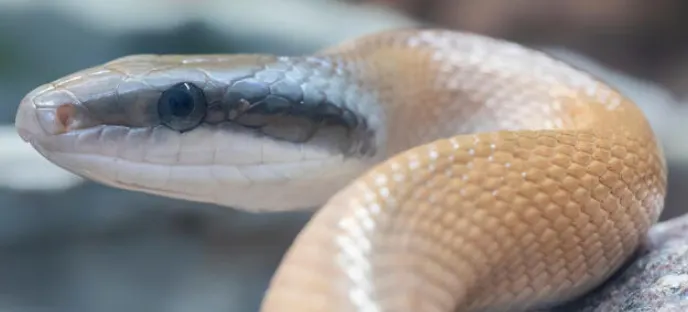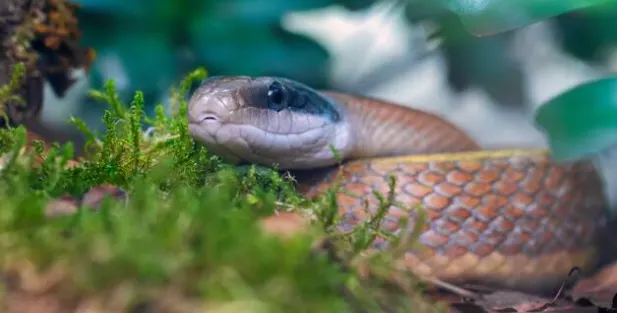The beauty rat snake, scientifically known as Orthriophis taeniura, is a captivating reptile admired for its striking appearance and pest control capabilities. Found primarily in eastern and southeastern Asia, this snake is relatively harmless to humans if left undisturbed and plays a crucial role in maintaining the ecological balance by preying on rodents.
Table of Contents
Scientific Classification
- Kingdom: Animalia
- Phylum: Chordata
- Class: Reptilia
- Order: Squamata
- Family: Colubridae
- Genus: Orthriophis
- Scientific Name: Orthriophis taeniura

Conservation Status
The beauty rat snake is listed as Vulnerable by the IUCN. Despite being a vital part of the ecosystem, its population faces threats due to habitat loss and the pet trade.
Habitat and Distribution
Beauty rat snakes inhabit various regions across Asia and Eurasia. Their presence is most notable in countries like Taiwan, Japan, and parts of China and Vietnam. These snakes thrive in environments such as forests, caves, and rocky areas where they can use their climbing skills to hunt and navigate.
Physical Characteristics
- Color: The beauty rat snake exhibits a range of colors from yellowish-brown to olive green. The tail is darker than the head, and the body features two pairs of black spots along the back.
- Skin Type: Scales
- Lifespan: 15-25 years
- Length: 4-6 feet, with some subspecies reaching up to 7 or 8 feet.
Behavior and Diet
These snakes are solitary creatures, except during the mating season. They are versatile in their hunting habits, being nocturnal, diurnal, or crepuscular based on availability of prey and environmental conditions. Their diet primarily consists of rodents, such as rats and mice, but they can also consume bats and occasionally baby chicks when kept as pets.
Reproduction
The beauty rat snake lays clutches of 4-12 eggs, which incubate for about 70 days. The hatchlings shed their skin for the first time two weeks after birth and continue to grow rapidly, reaching a length of at least four feet before they are ready to mate.
Interesting Facts
- Diet Flexibility: While they primarily eat rodents, beauty rat snakes can use their climbing abilities to hunt bats in caves.
- Clutch Size: They lay between 4-12 eggs per clutch, with an incubation period of about 70 days.
- First Shedding: Baby beauty rat snakes shed their skin for the first time two weeks after hatching.
- Natural Predators: Birds and mammals are the main predators of beauty rat snakes.
- Pest Control: Many people allow these snakes to remain in their gardens as natural pest controllers due to their appetite for rodents.
Subspecies
The beauty rat snake has 10 known subspecies, each with unique characteristics and distributions:
- Chinese Beauty Snake: Found in Russia, with 11 variations.
- Ridley’s Beauty Snake: Also known as the cave-dwelling rat snake, found in China and bred in the Cameron Highlands.
- Mocquard’s Beauty Rat Snake: Located in southeastern China and northern Vietnam.
- Taiwan Beauty Snake: Native to Taiwan.
- Vietnamese Blue Beauty Snake: Found in Vietnam, Cambodia, and Thailand.
- Helfenberger’s Beauty Snake: Lives in Thailand and Myanmar.
- Orthriophis taeniura grabowskyi: Found in Sumatra, East Malaysia, and Kalimantan.
- Orthriophis taeniura schmackeri: Native to the Ryukyu Islands in Japan.
- Orthriophis taeniura yunnanensis: Located in Vietnam, China, India, Laos, Myanmar, and eastern Thailand.
- Orthriophis taeniura ssp.: Found in Myanmar, Vietnam, and Thailand.
Appearance and Identification
The beauty rat snake is known for its elongated body and distinctive coloration. Here are some key identifying features:
- Body Color: Ranges from olive green to yellowish-brown.
- Spots: Two pairs of black spots along the back.
- Tail: Darker than the head.
- Stripe: A stripe extends from the back corner of the eye across the mouth.
- Pale Mouth: The mouth is pale cream in color.
- Size: Generally 4-6 feet long, with some subspecies reaching up to 9 feet.
Danger to Humans
While the beauty rat snake is not venomous, it can bite if threatened. Their bites, though painful due to bacteria, do not require extensive medical care. They prefer to avoid human interaction and will flee if given the opportunity.
Pet Trade and Care
Beauty rat snakes are popular in the pet trade due to their calm demeanor and striking appearance. However, they require specific care to thrive, including proper humidity, heat,
Conservation Efforts
The beauty rat snake faces threats from habitat destruction and over-collection for the pet trade. Conservation efforts focus on protecting their natural habitats and regulating trade practices to ensure the species’ survival.
The beauty rat snake, with its vibrant colors and essential role in pest control, is a fascinating species worth preserving. Understanding their behavior, habitat, and needs can help in making informed decisions about their conservation and care. Whether in the wild or as pets, these snakes continue to captivate and intrigue reptile enthusiasts around the world.
Frequently Asked Questions About Beauty Rat Snakes
Are beauty rat snakes venomous?
No, beauty rat snakes are not venomous. While they can bite if threatened, their bite is not dangerous to humans beyond the potential for minor pain and bacterial infection.
How big do beauty rat snakes get?
Beauty rat snakes typically reach a length of 4-6 feet, with some subspecies growing up to 7 or 8 feet. The largest recorded beauty rat snake measured just under 9.2 feet.
Do beauty rat snakes make good pets?
Yes, beauty rat snakes can make good pets for experienced reptile keepers. They are relatively easy to care for, requiring proper humidity, heat,

What do beauty rat snakes eat?
Beauty rat snakes primarily feed on rodents such as rats and mice. They can also climb to catch bats and may be fed baby chicks by some pet owners.
Where are beauty rat snakes found?
Beauty rat snakes are native to various regions in eastern and southeastern Asia. They can be found in countries like Taiwan, Japan, China, Vietnam, and others. They inhabit forests, caves, and rocky areas where they can use their climbing skills.
How do beauty rat snakes hunt?
Beauty rat snakes are versatile hunters, active during the day or night, depending on prey availability. They use their climbing skills to catch rodents and bats, constricting their prey before consumption.
What is the conservation status of beauty rat snakes?
The beauty rat snake is listed as Vulnerable by the IUCN. Their population is threatened by habitat loss and over-collection for the pet trade.
What are the natural predators of beauty rat snakes?
The main natural predators of beauty rat snakes are birds and mammals. There are no known animals that exclusively prey on beauty rat snakes.
How do beauty rat snakes reproduce?
Beauty rat snakes lay clutches of 4-12 eggs, with an incubation period of about 70 days. Hatchlings shed their skin for the first time two weeks after birth and grow rapidly.
Can beauty rat snakes be kept with other pets?
Beauty rat snakes are best kept alone, especially from potential prey animals like rodents. They can coexist with other reptiles under careful supervision and proper enclosure setups.
How long do beauty rat snakes live?
Beauty rat snakes have a lifespan of 15-25 years when kept in optimal conditions, making them a long-term commitment for pet owners.
What should I consider before getting a beauty rat snake as a pet?
Before getting a beauty rat snake, ensure you have the proper enclosure, equipment, and knowledge to meet their care requirements. Research their diet, humidity, temperature needs, and handling practices to provide a healthy environment for your snake.
- Enchi Ball Python: A Unique and Stunning Morph of Python regius - March 27, 2025
- Emerald Tree Monitor: The Enigmatic Green Guardian of the Rainforest - March 26, 2025
- The Egyptian Cobra (Naja haje): A Fascinating Serpent - March 25, 2025
